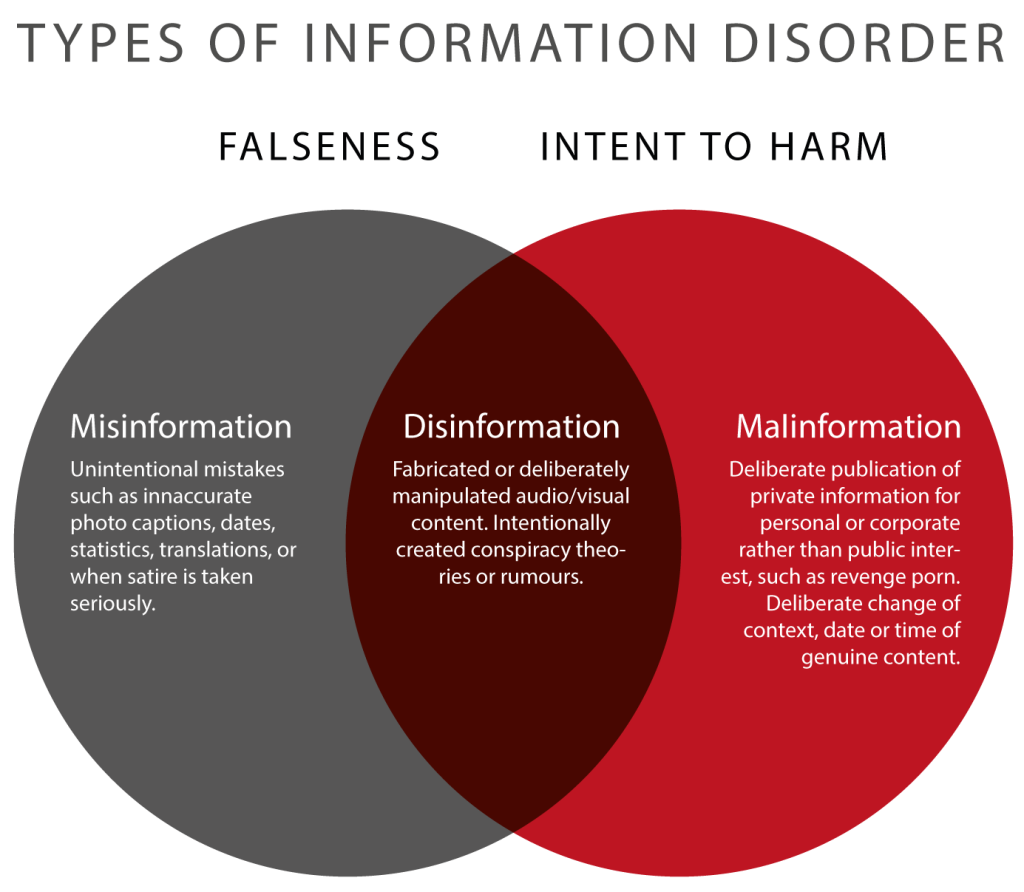40 Choosing Credible Web Sources: Red Flags
Gina Kessler Lee
Learning Objectives
By the end of this chapter, you should be able to
- Define misinformation, disinformation, malinformation, content marketing, and bias
- Identify examples of each of these
Why is it important to check a website for credibility before trusting it or using it in a college assignment? Why does bad information exist on the internet? Here are a few reasons:
Misinformation, Disinformation, and Malinformation
Domestic and international political actors have weaponized the internet’s ability to transmit information quickly to sow fear, antagonism, and distrust. Not all web searches will bring up intentionally incorrect information, but some might, especially if you’re researching something that’s politically controversial.
This chart explains the difference between misinformation, disinformation, and malinformation:

Fig. 40.1. A Venn diagram of the relationship between misinformation, disinformation, and malinformation.[Image Description]
Content Marketing: Web Writers for Hire
Even if a website isn’t intentionally misleading you, it might not be written by an expert on the topic. In fact, it might be written by someone who has no more expertise on the topic than you do. Many websites are intended as content marketing, which means they are just trying to address topics that people often search Google for information on, so their website shows up in Google results, and they drive traffic to their website, where they sell a service.
For example, you might search Google for a skin issue you’re having, click on a search result that seems to address your issue, and be taken to the website of a dermatologist. That website might have information that’s written by a dermatologist, but it’s just as likely to be written by a freelance copywriter who got paid to write a bunch of webpages on skin issues. They are paid, along with search-engine optimization (SEO) experts, to get consumers like you to happen upon the dermatologist’s website. Even if you weren’t originally looking for a dermatologist, now you are on their website, where they can serve you ads for new-patient discounts, and ka-ching! They might have just gotten themselves a new customer. While seeking medical advice from a licensed practitioner can certainly be a better option than diagnosing yourself with “Dr. Google,” you might also have just made a decision based on some web content that wasn’t written by an expert.
And these days, business owners don’t even need to pay a human to write their content marketing. They can generate all the clickbait they want with the help of generative AI chatbots like ChatGPT (Coffee).
Just because it’s content marketing doesn’t mean it’s not reliable. The Mayo Clinic in Minnesota is one of the most respected medical institutions in the United States. Its website has a ton of medical information intended to both provide credible medical information that is vetted by doctors and draw potential patients to its website. It goes beyond search-engine optimization to actually partner with Google to feature its content (Ramaswami). (And it now makes money licensing its medical articles to other healthcare providers too. [“Licensable Content.”]) So just make sure that you can recognize content marketing, check if the author is an expert on the topic, and if it has been edited or fact-checked by an expert too. And consider if there might be a better source on the topic. Just because it appears at the top of your Google search results doesn’t mean it’s the best source for your purposes.

Bias
None of us is without biases. While some news organizations and websites try to minimize those biases in their content, they still have to make calls on what issues and events to cover and how. Other news organizations and websites might lean into a particular political viewpoint. Some might lie to achieve their aims, while others stick to facts.
However, while some assertions are demonstrably false, many facts and statistics can support different conclusions, depending on which facts are chosen and how they’re framed.
For example, deciding whether crime has gone up or down in your city, state, or country might depend on which types of crime you’re looking at, what time period you’re considering, and whether the methods for tracking crime changed over that period. And when it comes to blaming or giving credit for those changes in crime rates, different pundits or politicians might point to many different factors: for example, the policies of the previous administration, law enforcement funding, the economy, and more. One set of facts can often have different, and sometimes equally valid, interpretations.
Image Descriptions
Fig. 40.1 Image Description. A Venn diagram with two overlapping circles is shown. The first circle, “Misinformation” is under the heading of “Falseness.” The second circle, “Malinformation” is under the heading of “Intent to Harm.” Where the two circles overlap, it is labeled “Disinformation.” Definitions are provided for all three: Misinformation – Unintentional mistakes such as inaccurate photo captions, dates, statistics, translations, or when satire is taken seriously. Disinformation- Fabricated or deliberately manipulated audio/visual content. Intentionally created conspiracy theories or rumours. Malinformation – Deliberate publication of private information for personal or corporate rather than public interest, such as revenge porn. Deliberate change of context, date, or time of genuine content.[Return to Fig. 40.1]
Attributions
“3 Types of Information Disorder” graphic by Claire Wardle & Hossein Derakshan is licensed under CC BY-NC-ND 3.0
Works Cited
Coffee, Patrick. “Marketers Are Putting More Content and Quality Control in the Hands of AI.” Wall Street Journal, 17 Apr. 2025, https://www.wsj.com/articles/marketers-are-putting-more-content-and-quality-control-in-the-hands-of-ai-de844638.
“Licensable Content.” Mayo Clinic Health Education and Content Services, https://gbs.mayoclinic.org/licensable-content.php.
Ramaswami, Prem. “A remedy for your health-related questions: health info in the Knowledge Graph.” The Keyword, Google, 10 Feb. 2015, https://blog.google/products/search/health-info-knowledge-graph/.
Media Attributions
- Mayo Clinic Google Search result adapted by Gina Lee is licensed under a CC0 (Creative Commons Zero) license
